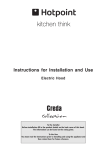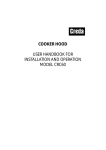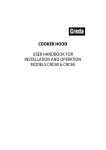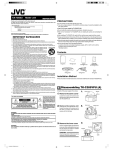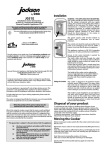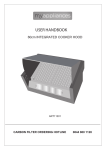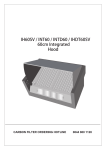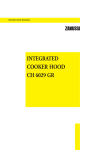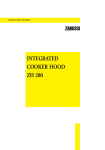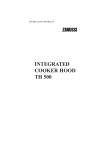Download Hotpoint HTN40 User's Manual
Transcript
COOKER HOOD USER HANDBOOK FOR INSTALLATION AND OPERATION MODEL HTN40 Your new Cooker Hood Using your new Cooker Hood is very simple. Nevertheless, to get the best results it is important that you read this handbook thoroughly before installing and using your appliance for the first time. Electrical Requirements Any permanent electrical installation must comply with the latest I.E.E. Regulations and local electricity company regulations. For your own safety, this should be undertaken by a qualified electrician eg. your local electricity company or a contractor who is on the roll of the National Inspection Council for Electrical Installation Contracting (NICEIC). Please ensure that when the appliance is installed it is easily accessible for the engineer in the event of a breakdown. INCORRECT INSTALLATION COULD AFFECT THE SAFETY OF THE APPLIANCE If the Cooker Hood is permanently wired in, it must be via a suitable double pole isolating switch placed in a readily accessible position adjacent to the unit. Electrical Connection Before connecting to the mains supply ensure that the mains voltage corresponds to the voltage on the rating plate, inside the Cooker Hood. WARNING: THIS APPLIANCE MUST NOT BE EARTHED! It is fitted with a 2 core mains supply cable and must be permanently connected to the electricity supply via a double pole switch having 3mm minimum contact gap on each pole. A Switched Fuse Connection Unit to BS 1363 Part 4, is a recommended mains supply connection accessory to ensure compliance with the Safety Requirements applicable to fixed wiring instructions. DISCONNECT THE COOKER HOOD FROM THE MAINS SUPPLY BEFORE CARRYING OUT ANY KIND OF MAINTENANCE OR CLEANING. WARNING: CHILDREN SHOULD NOT BE ALLOWED TO PLAY WITH THE APPLIANCE OR TAMPER WITH THE CONTROLS. CE marking certifies that this appliance conforms to the following EEC directives:Low Voltage Equipment - 72/23/EEC Electromagnetic Compatibility - 89/336/EEC 2 Contents Page Electrical Requirements Get to know your Cooker Hood Installing your Cooker Hood Installation for Recirculation Installation for Extraction Mounting Height Mounting between Cabinets Fitting the Decor Panel Operating your Cooker Hood The Controls Do’s and Don’ts Caring for your Cooker Hood Filters and their Replacement Cleaning How to Replace the Light Troubleshooting Key Contacts 2 4 5-9 10 11-12 13 Back Cover Appliance manufactured in EU. Retention of the Instruction Book This Instruction Book must be kept handy for reference as it contains important details on the safe and proper use of the appliance. If you sell or pass the appliance to someone else, or move house and leave it behind, make sure this Book is also provided so the new owner can become familiar with the appliance and safety warnings. If the book is lost or damaged a copy may be obtained from: GDA Ltd., Morley Way, Peterborough, PE2 9JB 3 Get to know your Cooker Hood. Unpacking Before installation, ensure that you have removed all packing pieces. Fitted Door (not supplied Door support Controls Filter Grille Grille release Dimensions Height Width Depth 400mm (153/4in) 600mm (235/8in) adjustable from: 270mm (105/8in) up to 460mm (18in), excluding the decor panel thickness. All measurements are in millimetres. 4 Light Installing your Cooker Hood Your new Cooker Hood can be installed either for recirculation or extraction through an outside wall. (All fitting supplied) Installation for Recirculation: If it is not possible to exhaust to the outside, the hood can be used to filter and recirculate the air (Fig.1). Fig.1 Installation for Extraction: This method is recommended if at all possible. Fumes and grease laden air are drawn into the underside of the hood and expelled outside the kitchen. The air can be expelled either upwards through a ventilating shaft (Fig.2) or directly through a wall to the outside (Fig.3). Ducting will be required if the Cooker Hood is mounted away from the outside vent. Fig.2 Your hood can be fitted with a carbon filter (optional extra) to remove odours (for fitting, see page 11). The carbon (charcoal) filter can then be fitted. NOTE: The hood is more efficient in the exhaust mode, therefore this position should be selected during the warmer months of the year when no heating is being used. When the room is being heated, if the recirculation position is selected heat will not be wasted. To obtain the best performance it is advisable to switch on the hood a few minutes before you start cooking and leave it running approximately 15 minutes after finishing. Fig.3 IMPORTANT: The exhaust air must not be expelled through a smoke or waste-gas chimney which is in use or through a shaft used for ventilating rooms or into the cavity of a cavity wall. If the room contains a flued fuel burning appliance, such as a gas or oil fired central heating boiler, which is not of the ‘Balanced Flue’ type, you should make sure that there is adequate air inlet into the room at all times so that fumes from the boiler are not drawn back into the room by the Cooker Hood. NOTE: All installations must comply with local authorities and building regulation requirements for the discharge of exhaust air into the atmosphere. 5 Installing your Cooker Hood Top or Rear Extraction Fig.4 Connect the ducting material onto the flange: blank off the aperture which is not required. The charcoal filter is not required when the hood is installed in the ducting cycle. To remove the grille turn the locks (Fig.5 B) and pull the grille out and downwards. Fig.5 Ducting: In order to obtain satisfactory air extraction, long ducts should not be used. Exhaust pipes with as smooth an inner wall as possible are recommended. The ducting MUST be manufactured from a fire retardant material. Wall Vent Kit: For connecting the Hood either directly through a wall or in conjunction with a ducting pipe, we recommend the use of a Wall Vent Kit. A 3m extension pipe is also available. These may be obtained from your nearest retailer or the Genuine Parts and Accessories Mail Order Hotline (see back cover) and must be used where there is a cavity wall. Specific installation instructions are included with the Wall Vent Kit. NOTE: The Wall Vent Kit has a diameter of 100mm. 6 Installing your Cooker Hood MOUNTING Your Cooker Hood is designed to fit between two wall cupboards 600mm apart and to take a door panel measuring 400mm (min) to 600mm (max) in height, to match the adjacent cupboards, Mounting Height: The bottom of the hood should be no less than 650mm above an electric hob, 750mm above a gas hob or mixed fuel cooker, 400-450mm above a high level grill/top oven. For the best results, the hood should be mounted as near as possible to the minimum recommended height. WARNING: The fan motor of this appliance incorporates a thermal cut-out device which will operate if the hood is installed below the minimum recommended heights listed above, or if the motor becomes overheated. If the cut-out device is activated, switch off the fan motor and allow the hood to cool. The cut-out device will reset itself when the fan motor has cooled significantly. NOTE: This hood has been designed and approved for installation over an electric hob with a maximum input of 7kW or a gas hob with a maximum input of 10kW when fitted in accordance with the heights recommended above. Mounting between cabinets on the Wall: The hood may be fixed to any rigid vertical surface. If the hood can only be fixed to a hollow construction plaster or partition board structure, then the wall must be sufficiently reinforced to enable the hood to be fixed securely in position. Ensure that the cupboard is securely fixed to the wall, then proceed as follows: Place the template provided on the wall between the cupboards and drill the holes indicated. Fig.6 Place the wall plugs provided into the drilled holes (Fig.6). In cases where the wall plugs provided are not suitable for the type of wall ie. plaster board or cavity, appropriate fittings should be obtained. Fig.7 Adjust the position of the upper brackets (Fig. 7 B). Fit the hood to the hooks by means of the two brackets B. Ensure that the hood is at the right height, the height of the hood can be adjusted with the help of the screws (Fig.7 S). The hood can be fitted to the cupboards as detailed under the heading ‘Fitting the Hood to the Cupboards’. in the event that the side cupboards are considered to be inadequate to support the weight of the hood, the hood should be fixed to the wall as well as to the side of the cupboards. 7 Installing your Cooker Hood Fixing the Hood to the Cupboards: Place the template on the side of the right cupboard, so that the letter B aligns with the front part of the cupboard (disregard the thickness of the door) and drill two holes 2.5mm diameter at points B1 and B2 (Fig. 8). Fig.8 Replace the visor with decor panel, inserting it first in the upper slides and then in the lower slides. Turn the rear locking knobs anti-clockwise until it stops and then mount the grille by lifting it up - pushing inwards and turn the locks to secure. Once the Hood has been fixed, if the cupboards are deeper than the hood, mount spacer (Fig.11 S) and secure it with the two screws Fig.11 T) 3.5 x 13 and washers on the back of the hood. Fig.11 Place the same template on the side of the left cupboard ensuring that side C aligns with the front part of the cupboard (disregard the thickness of the door) and drill two holes 2.5mm diameter at the point C1 and C2 (Fig.9). Fig.9 Fit the hood to the cupboard by means of the screws (Fig.10 E). Fig.10 8 The spacer is reversible to cover a gap from 1 to 4cm. Installing your Cooker Hood Fitting the Decor Panel: The hood is designed to be fully integrated into the kitchen by fitting a decor panel onto the visor to match the adjoining kitchen cabinets. To fit the decor panel remove the complete visor assembly from the hood. First open grille (Fig.12 A) turning the locks (Fig.12 B). Fig.12 Remove the visor by first turning the two locking knobs (Fig.13) in clockwise direction. Fig.13 Place the template supplied on the rear side of the decor panel, ensuring that the arrow aligns the upper edge of the panel (Fig.14). Fig.14 Drill the holes where indicated on the template and fit the door to the decor panel by means of screws (Fig.15 D). Fig.15 9 Operating your Cooker Hood The Controls Make sure that the Cooker Hood is wired in and the power supply is switched on. The Cooker Hood functions are controlled by two slide switches located on the right hand side behind the visor. Fan Speed The top slider enables you to select the fan speed. Position 1, should be selected when simmering or using only one pan. Position 2 for normal cooking, up to four pans. Position 3 when frying or cooking foods with strong odours. Work Top Illumination The lower slider (ON/OFF) enables you to switch on the work top illumination. The concealed microswitch acts as an override and will switch the Hood ‘OFF’ when the visor panel is closed. When the visor panel is opened the hood will resume working at its previous setting. To obtain the best performance, it is advisable to switch on the hood a few minutes before you start cooking and leave it running for approximately 15 minutes after finishing. Do’s and Don’ts DO DON’T Do take extra care when frying. Do keep the heating areas on your hob covered over with pots and pans etc. when using the hob or Cooker Hood switch (especially if you are using a gas hob). Do make sure that there is an adequate air inlet into the room if you are using the hood to vent externally and have a boiler or fire in the room, so that fumes are not drawn back from the flue. Don’t Don’t Don’t NEVER NEVER 10 use the hood without the grease filter. leave a naked flame under the hood. leave cooker/hob hotplates ‘On’ when not covered, as the fan motor of this cooker hood incorporates a thermal cut-out device which will operate if the hood overheats. The fan motor will take approximately 20 minutes to automatically reset at which point the hood will resume normal functions. do flambé cooking beneath this cooker hood. leave frying pans or deep fat fryers unattended during use, overheated fat/oil may catch fire. Caring for your Cooker Hood Before doing any cleaning or replacing the filters or light bulb, always ensure that the electricity supply to the Cooker Hood is switched ‘OFF’. Filters and their replacement: THE GREASE FILTER Your Cooker Hood is fitted with a grease filter which absorbs grease, dust etc. and helps to keep the appliance clean inside. Gradually the filter will become saturated with grease. When this happens the grease filter must be replaced, usually about every two months depending on use. IMPORTANT: There could be a possible fire hazard if the grease filter is not replaced when necessary and according to these instructions. Replacement grease filters are available from your nearest retailer or our Genuine Parts and Accessories Mail Order Hotline (see back cover). REPLACING THE GREASE FILTER The grease filter should be replace every 2 months: 1. Pull the visor out as far as it will go. 2. Remove the filter grille by releasing the two slider catches at each side of the grille. 3. Push the clips to one side and remove. 4. Place the new grease filter in the filter grille. 5. Replace the retaining clips. Refit the grille panel into the hood. Fig.16 THE CARBON FILTER (Recirculation only) The activated carbon filter absorbs odours arising from the cooking. In use, the filter will slowly become saturated and gradually less effective. The filter will normally require changing every six months, depending on the amount and type of cooking you have done. TO FIT THE CARBON FILTERS The deflector (Fig.17 N) should be Fig.17 fitted over the hole, fixing it with the special screw provided. The deflector should be fixed to ensure the air flow is away from the wall to avoid dirtying or marking the rear wall . Place the new carbon filter, ensuring that points Q and R align (Fig. 18). To lock the filter turn in the direction of the arrow (Fig.18 S). Fig.18 The Hood must not be connected to ducting when in the recirculating mode. Regular replacement of the charcoal filter will ensure optimum performance from the hood when recirculating. TO REPLACE THE CARBON FILTER Remove the grille by turning the locks and pull the grille out and downwards. Remove the saturated carbon filter by rotating it in an anti-clockwise direction (Fig.19) and replace it with a new one. Fig.19 11 Caring for your Cooker Hood Cleaning: The exterior of the Cooker Hood should be cleaned regularly to keep it looking like new. Wipe over with a soft cloth, wrung out in warm water and dry with a clean soft cloth. Wear protective gloves. You can use mild non-abrasive cleaners but always read the manufacturer’s instructions first. Always test their suitability on a small area of the Cooker Hood not noticeable in normal use. NOTE: DO NOT use scouring pads or abrasive cleaners as they may scratch the surface. How to replace the light: Should the light fail to work, switch ‘Off’ the mains supply to the Hood. Open the grille and check the bulb is screwed securely into the bulb holder then switch ‘On’ at the mains supply and at the hood ‘ON/OFF’ control. If the light fails to work do not worry, it will not affect the working of your hood. Obtain a replacement 40 watt SES Clear (E14) bulb. Switch ‘Off’ the mains supply. Unscrew the old bulb anti-clockwise to remove and replace with the new bulb turning clockwise until secure. Refit the filter grille and switch back ‘On’ at the mains supply. NOTE: When changing the bulb, an identical replacement must be fitted to ensure the safe operation of the hood. 12 Troubleshooting. First, don’t panic! There may be nothing wrong at all. Look for your problem below, then check the things we suggest. More often than not, this will give you the answer to your problem, and you’ll be able to carry on without having to telephone your Service Office. It is not working! Are you using a plug and socket? - Check that the plug is firmly pushed in. - Check the power supply, by plugging in another appliance. - Has the fuse blown? It is not working! Is the mains lead wired directly into a double pole isolating switch? - Check that the wires in the mains lead are correctly connected. (See page 2) Parts Please remember your new appliance is a complex piece of equipment. ‘DIY’ repairs or unqualified and untrained service people may put you in danger, could damage the appliance and might mean that you lose cover under the Guarantee. If you do experience a problem with the appliance, don’t take any risks, call in a Service Engineer (See back cover). Our Parts are designed exclusively to fit only GDA Ltd appliances. Do not use them for any other purpose as you may create a safety hazard. The Cooker Hood is not working satisfactorily... - Check you have selected the correct fan speed. (See page 10) - Check you have left the cover over the recirculation grille on top of the Hood (extraction only), (See page 11). - Check if the grease filter needs replacing (See page 11). The light is not working... - Check the bulb is screwed in securely. - Replace the light bulb (See page12) The Cooker Hood switches off intermittently... - Check the mounting height above the hob is correct (See page 7). The heat from the hob may cause the fan motor to overheat/cut-out. If, after following these instructions, you are still having problems, contact your nearest Service Centre (See back cover). 13 14 15 Key Contacts Service Hotpoint has the largest appliance manufacturer’s service team in Europe, trained specialists directly employed by us to ensure your complete confidence. Repair Service UK: 08709 066 066 Republic of Ireland: 1850 302 200 You will be asked for the following information:Name, address and postcode. Telephone number Model / Serial number of the appliance Clear and concise details of the query or fault Place and Date of purchase (Please keep the receipt as evidence will be required when the engineer calls). Extended Warranty To join: UK 08709 088 088 Republic of Ireland: 1850 502 200 Genuine Parts & Accessories Mail Order Hotline UK: 08709 077 077 Republic of Ireland: (01) 842 6836 For further product information 08701 50 60 70 All Hotpoint Services are offered as an extra benefit and do not affect your statutory rights. General Domestic Appliances Limited, Morley Way, Peterborough, PE2 9JB Part No. FP077-01 LI1S8A Ed. 09/01




















